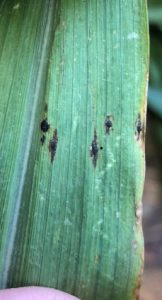Nematodes are roundworms that are extremely abundant in nature. Nematodes can have many different lifestyles, from feeding on bacteria, fungi, detritus, and other nematodes, to feeding on hosts such as humans, livestock, and plants. In field crops we are focused on plant parasitic nematodes. These are microscopic roundworms that obtain sustenance from a plant host. In Illinois, soybeans and soybean cyst nematode (SCN) receive (justifiably) a lot of attention. However, there are many other nematodes that are parasitic on field crops in the state. In this article I will focus on corn nematodes, thresholds, and sampling/analyses, as we are finalizing year three of our statewide corn nematode survey. Follow up articles will provide specific nematode profiles and management strategies.
There are several nematodes that can nibble in/on corn roots in Illinois. Most of these do not cause enough damage to reduce yields, as most corn is highly tolerant to nematode damage; however, some species of nematodes can be extremely damaging. Unlike SCN, the majority of corn nematodes are not sedentary, meaning that they do not have a portion of their lifecycle where they set up shop on plant roots. Rather, they are free living, and often move in and around the root system. Movement can depend on the species of nematode, soil temperature, soil texture, soil water, and other environmental factors. This means that unlike sedentary nematodes, most corn nematodes are moving targets, and consequently, even more difficult to study than SCN. Soil nematode densities and species vary depending on the aforementioned factors, plant growth stage, depth of sample, and time of year.
This brings up the first point I’d like to make regarding corn nematodes: sampling and thresholds, for the most part, are ambiguous. If you look across different nematode testing labs, you will see that damage thresholds vary depending on the facility, state, and soil type. This is in part due to corn nematodes being a moving target vertically and horizontally in the soil profile. Different species also differ in the amount of damage they can do- sting and needle nematodes for example, are large and cause extensive internal and external damage to roots, and typically a single nematode in a sample is reason for concern. Other nematodes, for example spiral and stunt nematodes, can be found at extraordinary numbers and not impact corn productivity. The relationship between parasitic nematode quantity and yield impact is further complicated when taking into account the fact that many parasitic nematodes are often found in a single field/sample and that although an individual species may not be at concerning/damaging levels, the collective impact of multiple parasitic species may reduce yields. With few exceptions, thresholds for free living plant parasitic nematodes are best guesses, and should be viewed as guidelines, not hard and fast management thresholds.
The time for sampling corn nematodes is another commonly asked question. The first thing to keep in mind is that these nematodes feed on roots and we cannot extract cysts/eggs or similar for most species affecting corn. This means that sampling should occur in fields with actively growing plants. Most labs will recommend sampling earlier in the season while plants are still in the vegetative stage of growth. Smaller plants may be more prone to damage due to nematodes due to the relatively small size of root systems and visual symptoms of damage more pronounced. In addition, some nematode species, such as needle and sting nematodes, can move several feet into the soil profile over the course of crop development, and often are missed or not acquired in samples taken later in the season. Early in the season these nematodes typically persist in the upper soil profile, as they are feeding on the developing, shallow root systems. Sampling between V4/7 in general, should give you the best chance of acquiring a fairly representative nematode sample across different soil types.
Quantification of corn nematodes might differ depending on the methods used as well. For example, when I ran the nematode assay at Delaware, I ran soil samples on Baermann funnels, which cause the living nematodes to wiggle through filter paper and collect at the bottom of a funnel. Only living nematodes are quantified using this technique. Other labs might use sucrose centrifugation. This method will separate all nematodes from the soil sample, living and dead, but might not allow nematodes within roots to be quantified. The take home here is that you should pick a nematode service and stick with it, as you will not need to take into account differences in extraction and enumeration techniques that exist among different testing facilities.

Sampling corn fields for parasitic nematodes should include representative areas of the field. A soil probe should be used to sample a minimum of 20 cores per 40 acres of field. Plastic ziplock bags or special wax lined paper bags should be used. Take cores at an angle through the root zone of the plant at a depth of 6-8 inches. Avoid sampling mucky/wet soils. Samples should be double bagged and placed immediately in a cooler on ice in the field. Samples can be stored in a fridge for a week or so until they can be dropped off or mailed to your preferred nematode assay service. Typically you will want to ship samples early in the week to avoid them arriving late on a Friday or over the weekend.
The University of Illinois has a full service Nematode Assay Service that is open for public use. Sampling and shipment information, as well as forms, can be found by clicking here.

